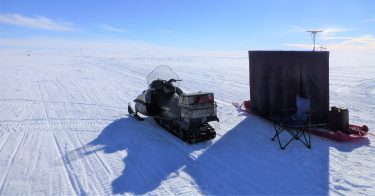
A region of West Antarctica is behaving differently from most of the continent’s ice: A large patch of ice there is thickening, unlike other parts of West Antarctica that are losing ice. Whether this thickening trend will continue affects the overall amount that melting or collapsing glaciers could raise the level of the world’s oceans.
A study led by the University of Washington has discovered a new clue to this region’s behavior: A volcano under the ice sheet has left an almost 6,000-year record of the glacier’s motion. The track hidden in the middle of the ice sheet suggests that the current thickening is just a short-term feature that may not affect the glacier over the long term. It also suggests that similar clues to the past may be hiding deep inside the ice sheet itself.
“What’s exciting about this study is that we show how the structure of the ice sheet acts as a powerful record of what has happened in the past,” said Nicholas Holschuh, a UW postdoctoral researcher in Earth and space sciences. He is first author of the paper published Sept. 4 in The Cryosphere.
Read more at UW Today »
